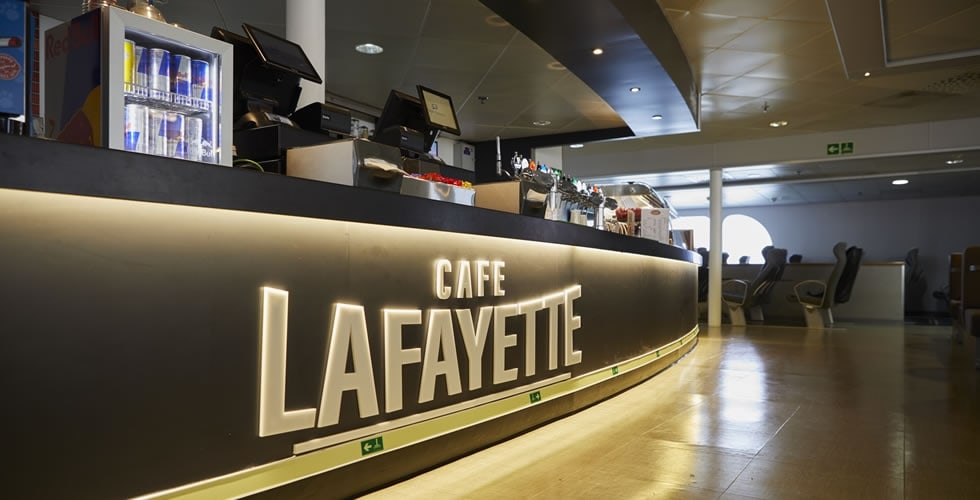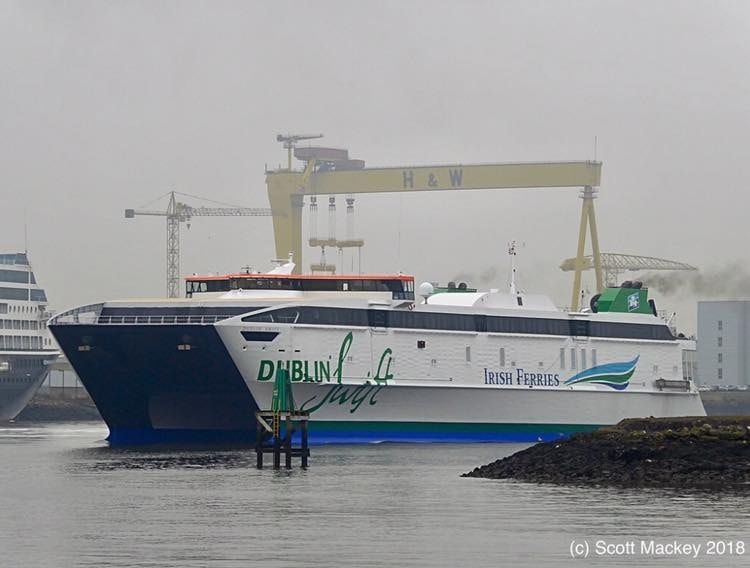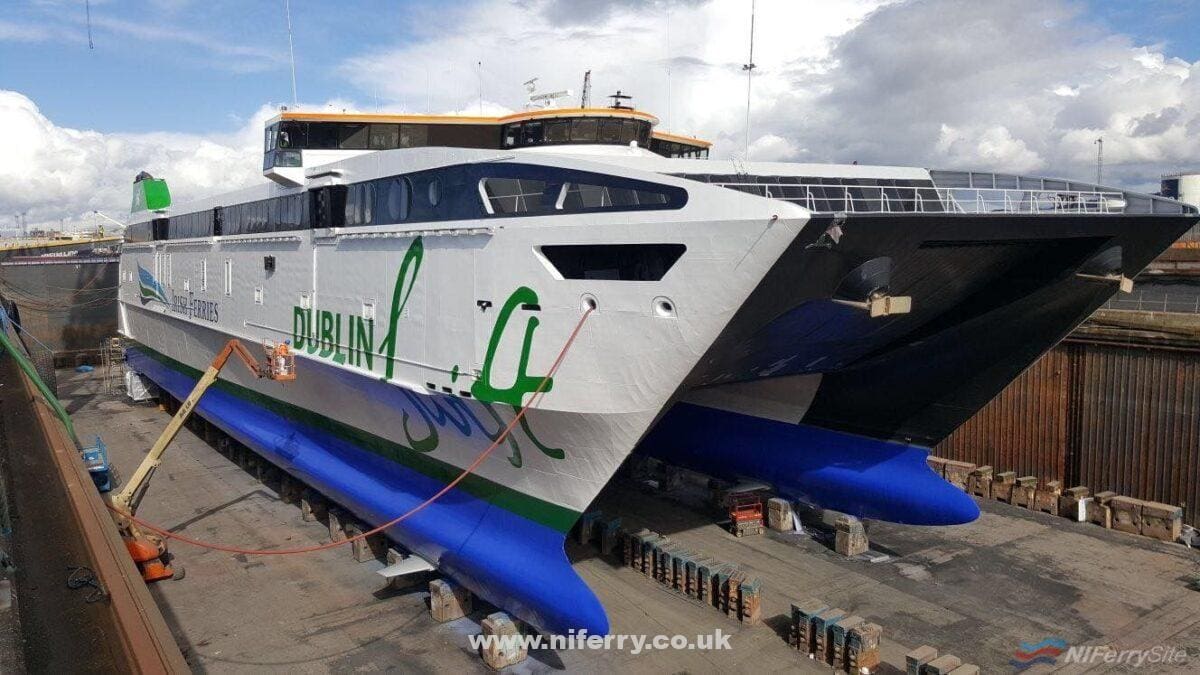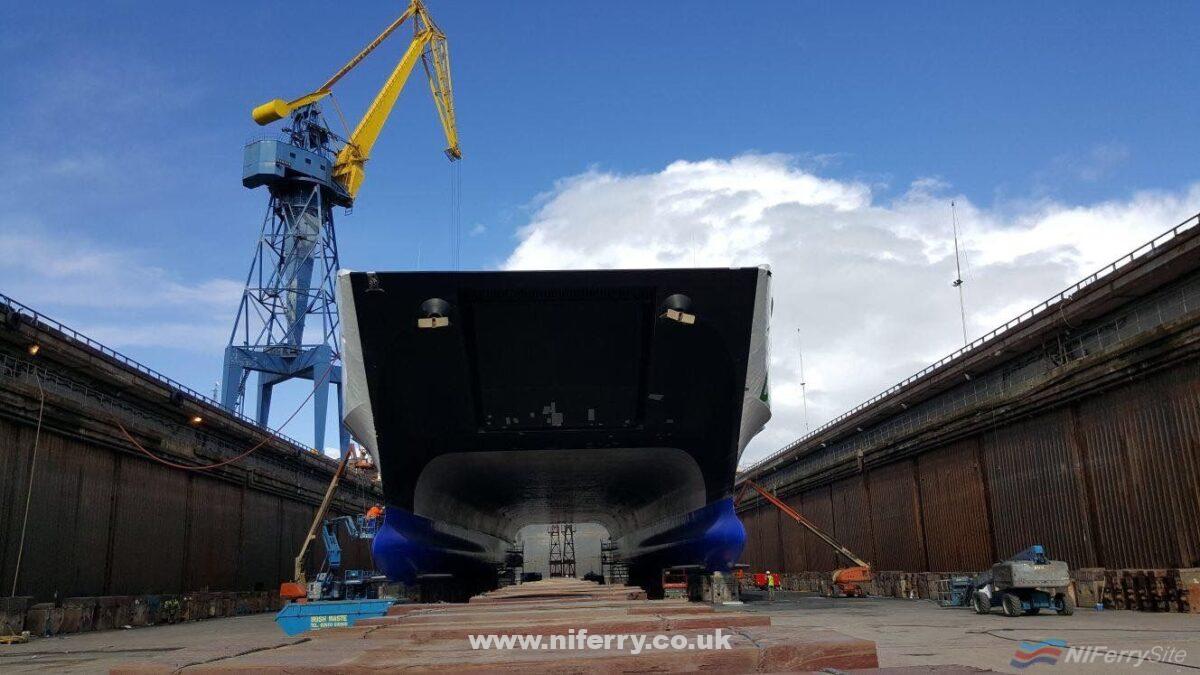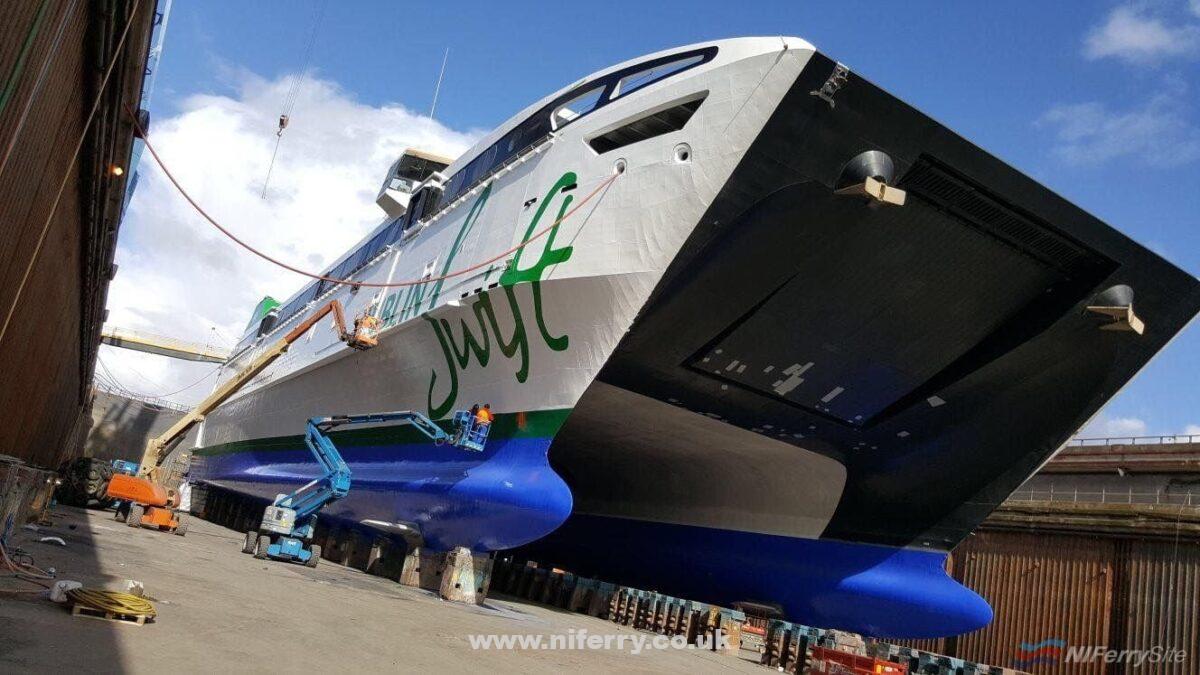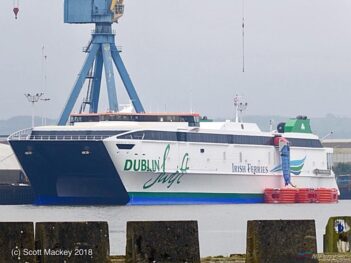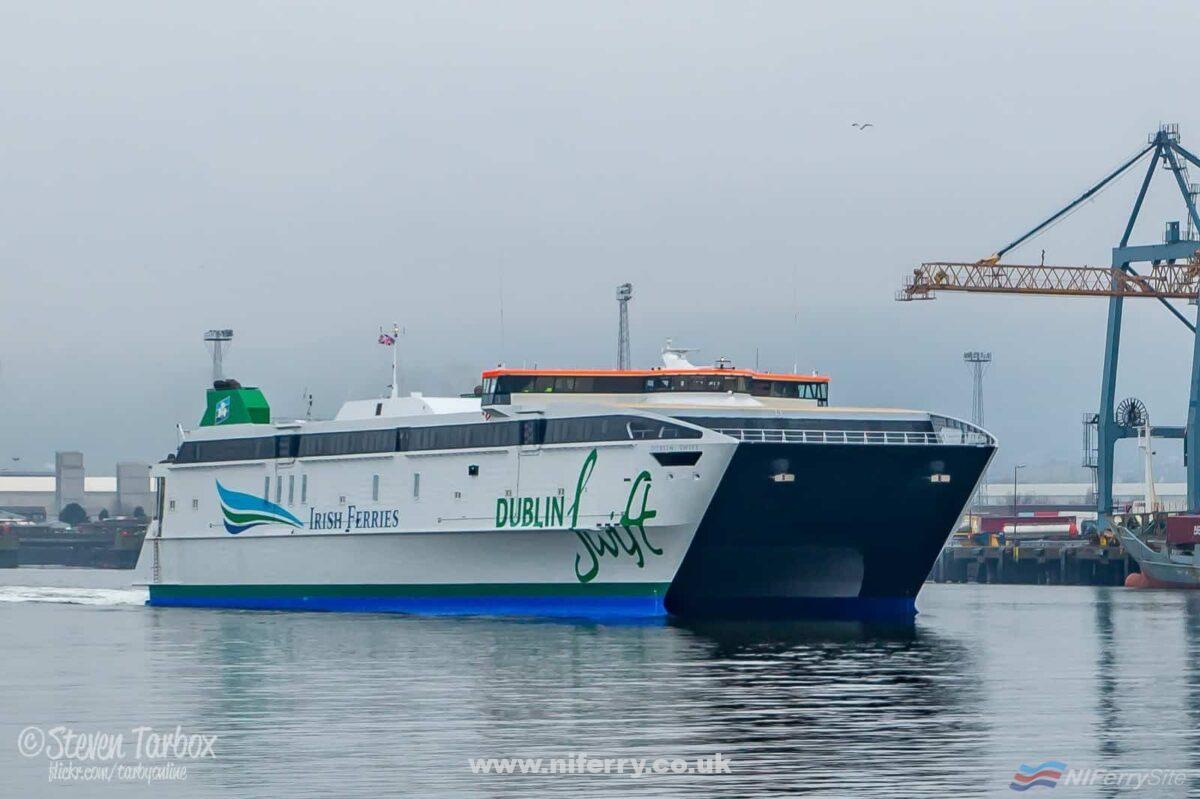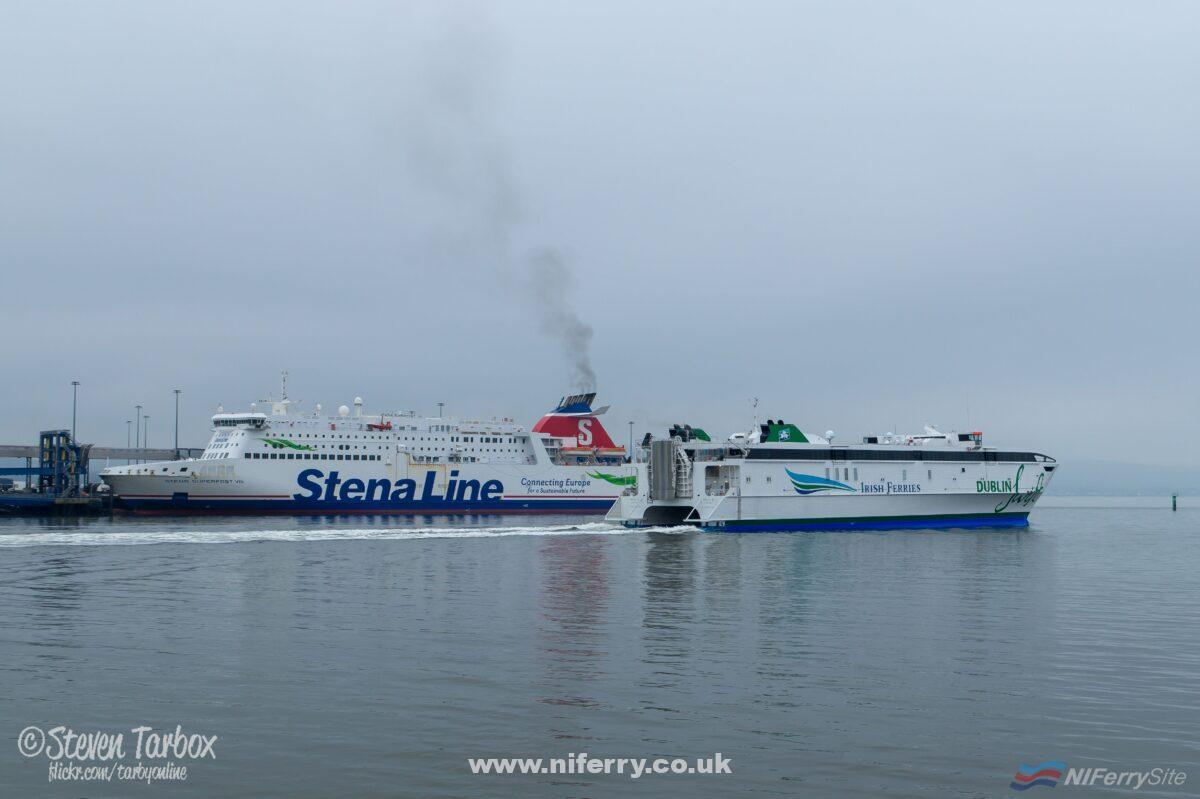Dublin Swift Fast Facts
| Current Name: Dublin Swift | Previous Names: WESTPAC EXPRESS / HSV-4676 |
| Shipyard: Austal Ships #130, | IMO Number: 9243227 |
| Current Operator: Irish Ferries | Current Route: Dublin [IE] - Holyhead [UK] |
| Length Overall: 101m | Beam: 26.64m |
| Passenger Capacity: 820 | Vehicle Capacity: 220 cars (2018 season) or 16 trucks / coaches (4.4m max height) plus an unspecified number of cars |
| Tonnage: 8,403 | Sister-ships: Virgen de Valle II (Euroferrys Pacifica) |
History and overview
DUBLIN SWIFT is a 101m long passenger and vehicle carrying catamaran constructed in Australia by Austal Ships. She was originally intended to operate as a commercial high-speed ferry in Europe based on the Austal AutoExpress
DUBLIN SWIFT‘s as-built sister vessel VIRGEN DEL VALLE II (ex EUROFERRYS PACIFICA) operates as a passenger and vehicle ferry in
Since her completion in 2001 until late 2017, she operated as a Theatre Support Vessel (TSV) in the Western Pacific as WESTPAC EXPRESS, capable of deploying an entire battalion of marines along with their support vehicles in a single “lift”. In this capacity she participated in humanitarian and disaster relief missions as well as military exercises.
Notably WESTPAC EXPRESS supported Operation Unified Assistance in Thailand after the 2004 Boxing Day tsunami in Asia, and provided support after the Tōhoku Tsunami in 2011.

In 2003 WESTPAC EXPRESS became the first large high-speed vessel to be registered and flagged as a commercial ship in the United States when her port of registry became Mobile in Alabama. In her 16 years of military service WESTPAC EXPRESS had an excellent reliability record of 99.8%.
She was replaced in Okinawa by the USNS GUAM (the former (civilian) Hawaii Superferry vessel HUAKAI) which was delivered by some members of the same crew which delivered WESTPAC EXPRESS, completing a journey of around 20,000 miles over the 2 trips.

Irish Continental group purchase
WESTPAC EXPRESS was purchased by Irish Continental Group, owners of Irish Ferries, from BALI Westpac 2006 LLC in April 2016 for US$13.25m. However, she continued to be chartered to the US Military contractor Sealift LLC until late 2017. I

n early January 2018 it was revealed on the NI Ferry (and shipping) Enthusiasts Facebook group (and the sister Ferries! Facebook group), that the former US Navy catamaran was due to arrive at Harland and Wolff for refurbishment on Monday 15th January 2018.
However, there was a change of plan, and following a quick stop at Holyhead’s T3 in the morning she arrived in Belfast on the afternoon of the 14th of January.

At the time Irish Continental Group had stated they had not yet made a decision whether to replace their existing fast craft on the Dublin to Holyhead route JONATHAN SWIFT with the larger WESTPAC EXPRESS or to charter her out externally, but they had confirmed that the vessel will be converted to passenger use and fitted out to their specifications.
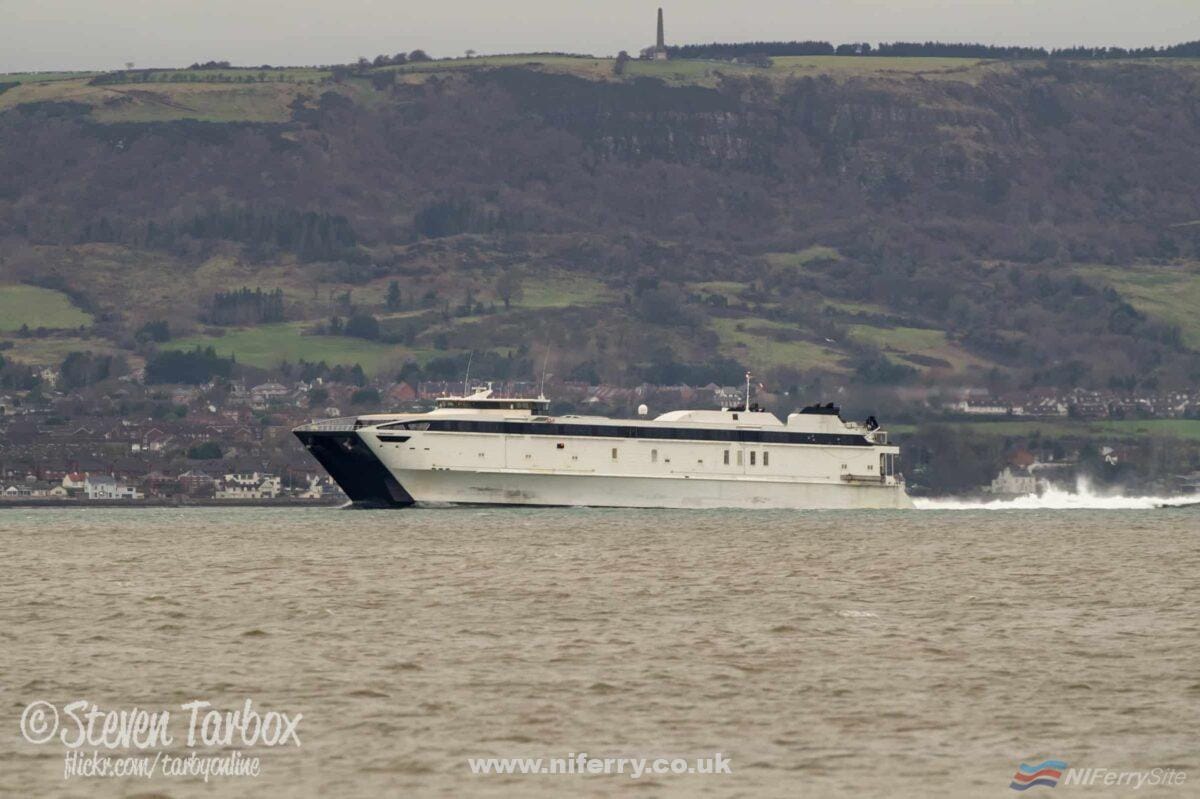
WESTPAC EXPRESS arrived in Europe from her former base in Naha (Okinawa, Japan) via Singapore, India, Oman, the Suez Canal, Malta and Algeciras where she sheltered for a while before making her way to Bilbao.
She left Bilbao (where she was also sheltering from weather) on the 12th January 2018 before crossing the Bay of Biscay, bound for Brest in France. She called at Holyhead on the morning of 14th January following an overnight voyage from the French port, and arrived in Belfast that afternoon.

Irish Ferries service
On the 30th of January 2018, Irish Ferries announced that WESTPAC EXPRESS was to replace JONATHAN SWIFT, which would be sold to Spanish operator Baleària. JONATHAN SWIFT is a smaller 86.6m long passenger and vehicle carrying catamaran also built to the Austal AutoExpress design, and has been in service on the Dublin – Holyhead route since her delivery from Austal to Irish Ferries in 1999.
JONATHAN SWIFT was dry-docked at Cammell-Laird Birkenhead at the end of January 2018, which is likely to be her last as an Irish Ferries vessel. She shared the dry-dock with fleet-mate OSCAR WILDE.

On the 3rd of February WESTPAC EXPRESS moved to the Cypriot flag from the US flag, having passed the relevant surveys while alongside the Ship Repair Quay (SRQ) in Belfast. In their preliminary annual results for 2017, released on 8th March 2018, it was revealed that WESTPAC EXPRESS is to be renamed DUBLIN SWIFT. This reflects the name that the fast-ferry between Dublin and Holyhead is marketed as.
The ferrybalear (in Spanish) blog revealed on 13/03/18 that JONATHAN SWIFT was to be renamed CECILIA PAYNE and would enter service on the 1st of June between Denia and Ibiza/Palma (Mallorca).
On the 11th of April 2018 the DUBLIN SWIFT moved to face the opposite direction on the ship repair quay in order for a test of the MES (Marine Evacuation System) to be carried out

First Season
DUBLIN SWIFT entered service between Dublin and Holyhead on 27th April 2018, operating the route along with the conventional vessels ULYSSES and EPSILON. The vessel she replaced, JONATHAN SWIFT (now CECILIA PAYNE), sailed between the 2 ports for the last time 2 days earlier. It is understood that initially, DUBLIN SWIFT used the T5 “Stena” berth at Holyhead as adjustments need to be made at the normal T2 fast-craft berth for the vessel to fit properly.
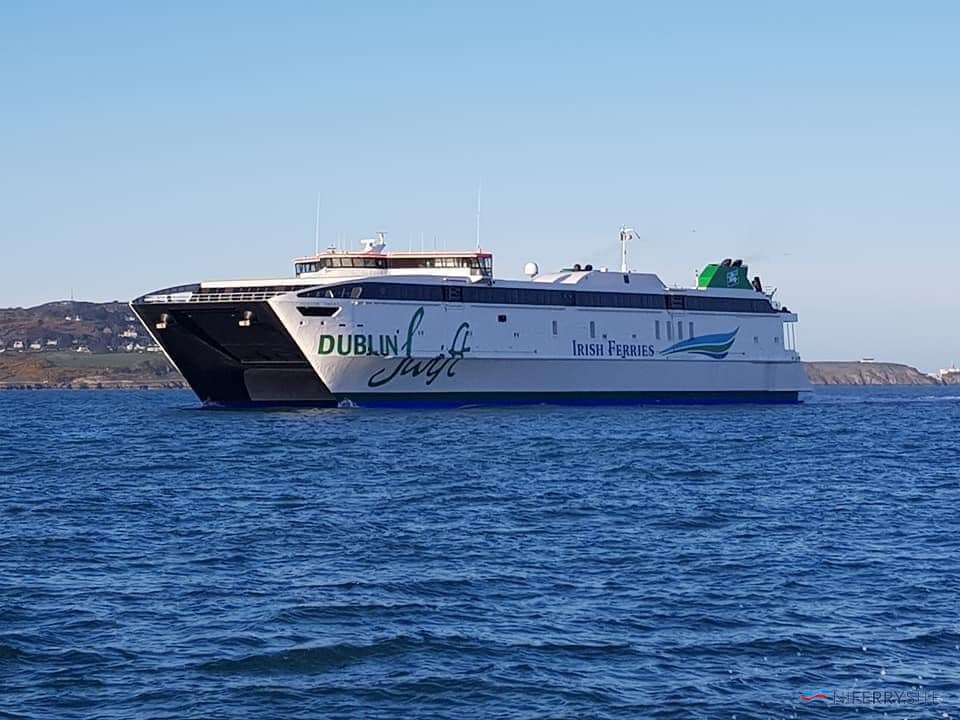
As she has a slightly slower service speed than the vessel she replaces, some adjustments have been made to the sailing schedule to account for a slightly slower crossing. Unfortunately, her maiden season on the Central Corridor was plagued with delays and cancellations due to both technical problems (particularly with her engines) and weather conditions.
Second Season and “upgrades”
During Autumn/Winter 2018/19 DUBLIN SWIFT laid over at Harland & Wolff Belfast were new mezzanine car decks were fitted in order to increase her car capacity. These decks were collected at Larne en route to Belfast due to the unavaillability of a suitable berth at Belfast for the time required. After going back in to service over the Easter Period, DUBLIN SWIFT went to dry dock at Cammell Laird in Birkenhead in May. Retractable Azimuth thrusters were added here in order to improve manoeuvrability.
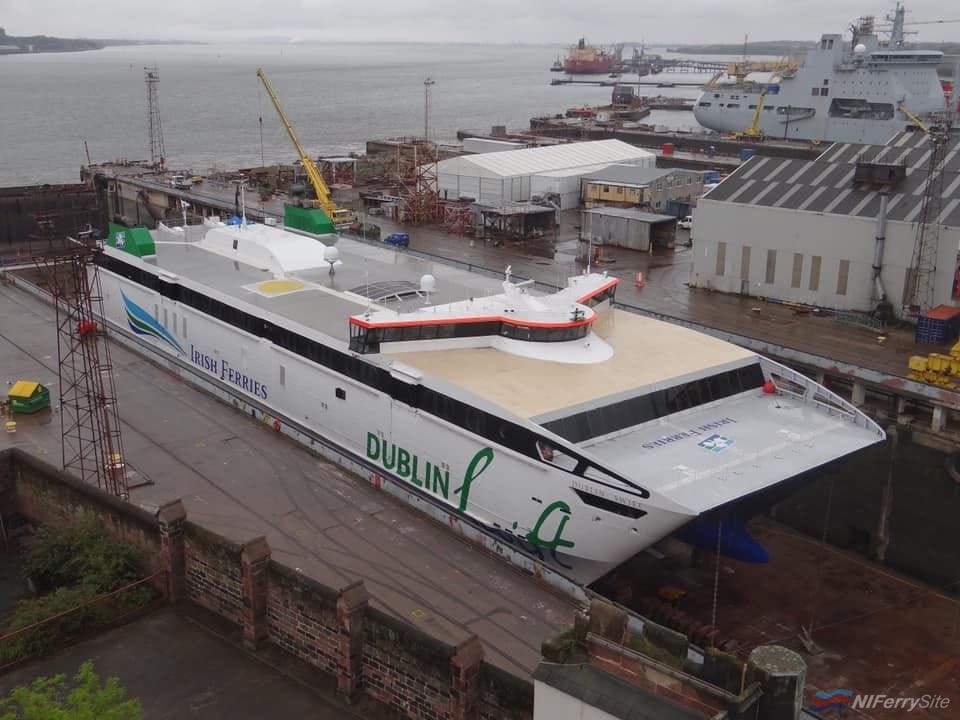
DUBLIN SWIFT had a second year plagued by technical problems during 2019, culminating in her being withdrawn from service early. On Saturday August 31st she crossed at reduced speed of around 22 knots to Holyhead, where she was met by the tugs AFON LASS and ST DAVID. The two tugs then assisted her onto the former HSS maintenance berth in the inner harbour.
By this stage Irish Ferries had removed the vessel from their booking engine and timetable for the remainder of her 2019 season which had been expected to last until the end of September. Pictures subsequently appeared on social media during early September appearing to show a crankshaft from one of the engines being removed from the vessel.

On the evening of Tuesday February 26, 2020, DUBLIN SWIFT returned to Belfast ahead of entering Belfast Dry Dock later in the week.
Due to the Covid-19 pandemic and the resulting travel restrictions, DUBLIN SWIFT was laid up again at Liverpool following her visit to Belfast. The ship returned to service on August 6, 2021. This was DUBLIN SWIFT‘s commercial sailing in almost 2 years. She continued in service until the evening of October 3.
Following the end of her 2021 season, DUBLIN SWIFT returned to Liverpool for layup on October 6.
Technical Data
| Name | DUBLIN SWIFT |
|---|---|
| IMO number | 9243227 |
| Built | 2001 Austal Ships, Freemantle, Australia |
| Yard number | 130 |
| Class |  DNV GL 100 A5 HSC-Passenger B Ro-Ro Type OC3 |
| Owner |  Irish Continental Group (ICG) |
| Previous Operator | Seaward Services (on behalf of the US Military) |
| Current Operator |  Irish Ferries |
| Length Overall (between perpendiculars) | 101 metres (86.2m) |
| Breadth | 26.64 metres |
| Draught | 4.29 metres |
| Gross tonnage | 8,403 |
| Conversion back to civilian use | Harland and Wolff, Belfast (14/01/18 – 13/04/18) |
| Machinery | 4 x Caterpillar 3618 V18 marine-Diesel main engines, each producing 7,200kW @ 1,050 rpm 4 x Caterpillar 3408 V8 auxiliary generator engines 4 x Reintjes VLJ 6831 gearboxes 4x Rolls-Royce KaMeWa 125 SIII water jets 2 x ZF AT 2010 RT-FP forward-mounted retractable Azimuth thrusters, each approx. 200kW (retrofitted at Cammell-Laird Birkenhead, May 2019). |
| Service speed (with ride control) | 35 knots |
A data sheet is also available to download from the Austal website here
Dublin Swift Gallery

Irish Ferries promotional image of Club Class onboard DUBLIN SWIFT. Irish Ferries 
Irish Ferries promotional image of Cafe Lafayette onboard DUBLIN SWIFT. Irish Ferries 
Irish Ferries promotional image of Club Class onboard DUBLIN SWIFT. Irish Ferries 
Irish Ferries promotional image of the (Aelia) shop onboard DUBLIN SWIFT. Irish Ferries 
The car deck on DUBLIN SWIFT with the mezzanine panels deployed. Copyright © David Faerder. 
DUBLIN SWIFT in Belfast Dry Dock (BDD), 28/03/17. Copyright © Gary Hall. 
DUBLIN SWIFT in Harland & Wolff’s Belfast Dry Dock (BDD). Courtesy of Matrix Ship Management. 
Irish Ferries DUBLIN SWIFT leaves Harland & Wolff after a 3 month long conversion from military to civilian use in early 2018. Copyright © Scott Mackey. 
DUBLIN SWIFT in Belfast Dry Dock (BDD), 28/03/18. Copyright © Gary Hall. 
DUBLIN SWIFT in Belfast Dry Dock (BDD), 28/03/18. Copyright © Gary Hall. 
DUBLIN SWIFT in Belfast Dry Dock (BDD), 28/03/18. Copyright © Gary Hall. 
DUBLIN SWIFT in Belfast Dry Dock (BDD), 28/03/18. Copyright © Gary Hall. 
DUBLIN SWIFT in Belfast Dry Dock (BDD), 28/03/18. Copyright © Gary Hall. 
DUBLIN SWIFT undergoing MES deployment at Harland and Wolff on 11/04/18 in preparation for commencing service between Dublin and Holyhead. Copyright © Scott Mackey. 
Irish Ferries’ Austal AutoExpress catamaran DUBLIN SWIFT passes Beflast’s Victoria Terminal 3 container terminal as she leaves Belfast for Dublin. This followed the conclusion of a comprehensive 3-month long refit and conversion project at Belfast’s Harland & Wolff shipyard. Copyright © Steven Tarbox 
Irish Ferries DUBLIN SWIFT on Harland & Wolff’s Ship Repair Quay, 4/4/18. Copyright © Scott Mackey. 
Dublin Swift leaves Harland & Wolff’s ship repair quay behind following completion of her conversion to civilian use, 13/04/18. Copyright © Scott Mackey 
DUBLIN SWIFT passes STENA SUPERFAST VIII as she leaves Belfast for Dublin. This followed a 3 month long refit and conversion to make the former WESTPAC EXPRESS suitable for use as a civilian ferry between Dublin and Holyhead. Copyright © Steven Tarbox 
Dublin Swift is seen leaving Belfast on Friday 13th April, following completion of her 3-month long refit at Harland and Wolff. Copyright © Steven Tarbox 
Irish Ferries Dublin Swift leaving Belfast 13/04/18. Copyright © Steven Tarbox 
DUBLIN SWIFT seen approaching Dublin in the distance between the hulls of newly renamed CECILIA PAYNE. CECILIA PAYNE would leave Dublin for the last time a little later. Copyright © Robbie Cox. 
ULYSSES, JONATHAN SWIFT and DUBLIN SWIFT seen at Dublin on 20th April 2018. Copyright © Robbie Cox. 
Irish Ferries DUBLIN SWIFT pictured at Larne during October 2018. Copyright © Steven Tarbox. 
DUBLIN SWIFT with the vessel she was soon to replace, JONATHAN SWIFT, in the background on 20th April 2018. Copyright © Robbie Cox 
Irish Ferries DUBLIN SWIFT arrives in Belfast on 25.10.18 having left Larne earlier that day. She had been in the County Antrim port loading new mezzanine vehicle decks. Copyright © Scott Mackey. 
Irish Ferries chartered Ro-Pax CARTOUR EPSILON conducting berthing trials in Dublin Port with JONATHAN SWIFT looking on, December 2013. Copyright © Gordon Hislip. 
Irish Ferries DUBLIN SWIFT leaves Cammell Laird Birkenhead on May 23rd 2019 following a planned dry docking for “mechanical upgrades”. Copyright © Das Boot 160 Photography. 
DUBLIN SWIFT in dry dock at Cammell Laird, 8th May 2019. Copyright © David Faerder. 
Irish Ferries promotional image DUBLIN SWIFT. Irish Ferries 
DUBLIN SWIFT. Copyright © Robbie Cox. 
Irish Ferries’ DUBLIN SWIFT. Irish Ferries.
[foogallery id=”21329″]
Original Article: 13.01.18
Last Updated: 09.09.19 (History Update & Gallery Added)



